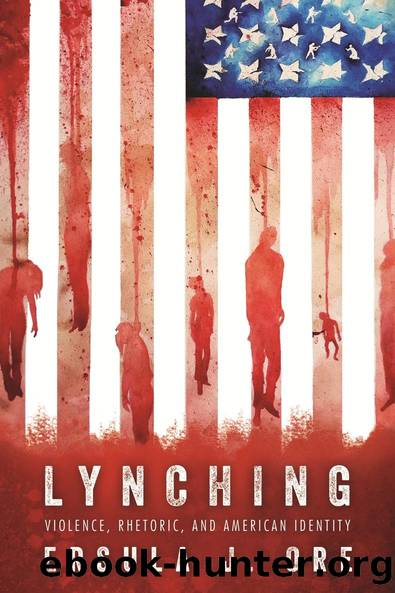Lynching by Ersula J. Ore

Author:Ersula J. Ore [Ore, Ersula J.]
Language: eng
Format: epub
ISBN: 9781496824080
Barnesnoble:
Publisher: University Press of Mississippi
Published: 2019-03-12T00:00:00+00:00
Without Sanctuary: A Lesson in Civics Continued
Central to this twenty-first-century recirculation of lynching photographs was the intent to use images of the past as a means of contextualizing the present. Artifacts placed within the context of a museum or a historical or cultural center do not present âlessonsâ or âargumentsâ on account of simply being housed within those spaces, but rather because of being pressed into meaning by the wall panels, wall text, brochures, audio, video, lighting, and overall architecture of those spaces. These features of what Schwartz calls the âexhibition apparatusâ work to build a narrative context and a rationale for their display.3 Requests for Without Sanctuary stemmed from the way the collection spoke to contemporary iterations of black death and state-sanctioned racialized terror. The police torture of Abner Louima (1997) and the killings of Amadou Diallo (1999) and Patrick Dorismond (2000) at the hands of city police were three incidents among a litany that contextualized the collectionâs year-long installation in New York. On August 9, 1997, after being accused of punching an officer in a scuffle, thirty-year-old Haitian immigrant Abner Louima was beaten while being transported to the 70th Precinct, strip-searched, and later sodomized by officers with a broom handle.4 On February 4, 1999, twenty-three-year-old Amadou Diallo was riddled with forty-one bullets when four plainclothes officers opened fire as he stood in the vestibule of his apartment. Diallo, who had been misidentified by officers as a serial rapist long since in police custody, had been reaching for identification as directed when he was shot.5 In the weeks that followed, New York City mayor Rudy Giuliani defended the four officers through statements that equated the violation of Dialloâs rights and the taking of Dialloâs life with the officersâ own fear of persecution. âThe death of Amadou Diallo was a great tragedy,â began Giuliani. âWe express once again our sympathyâ¦. There is no way we can comprehend what it means to lose a child.â However, he also said we must recognize that the officers involved âhave also gone through a nightmare.â6 Here, Giulianiâs apologist stance likens killing to indignity, and death to shame, in an effort to court sympathy for the officers. Equating the killing of an innocent, unarmed man to the humiliation of being (rightly) accused of murder as an officer of the law gravely reduced the value of Dialloâs black life by reasoning that the public should be as passionate about proving the officersâ innocence as they should be about seeking redress for the loss of Dialloâs life. As Giuliani reasoned, the ânightmareâ of being perceived as a murderer (as opposed to a threat) likewise demanded the communityâs compassion.
Several months later, on March 16, 2000, twenty-six-year-old Patrick Dorismond was shot and killed after being propositioned for drugs by an undercover officer outside a local nightclub.7 The officer and Dorismond, who was reportedly irritated over being approached, exchanged words. A fight ensued, at which point Dorismond was shot by another undercover officer, Det. Anthony Vasquez, who feared for the safety of his partner.
Download
This site does not store any files on its server. We only index and link to content provided by other sites. Please contact the content providers to delete copyright contents if any and email us, we'll remove relevant links or contents immediately.
Cecilia; Or, Memoirs of an Heiress — Volume 1 by Fanny Burney(31364)
Cecilia; Or, Memoirs of an Heiress — Volume 3 by Fanny Burney(30961)
Cecilia; Or, Memoirs of an Heiress — Volume 2 by Fanny Burney(30917)
The Great Music City by Andrea Baker(21965)
We're Going to Need More Wine by Gabrielle Union(18098)
Bombshells: Glamour Girls of a Lifetime by Sullivan Steve(13131)
Pimp by Iceberg Slim(12964)
All the Missing Girls by Megan Miranda(12795)
Fifty Shades Freed by E L James(12473)
Talking to Strangers by Malcolm Gladwell(11933)
Norse Mythology by Gaiman Neil(11927)
Crazy Rich Asians by Kevin Kwan(8385)
Mindhunter: Inside the FBI's Elite Serial Crime Unit by John E. Douglas & Mark Olshaker(7867)
The Lost Art of Listening by Michael P. Nichols(6499)
Enlightenment Now: The Case for Reason, Science, Humanism, and Progress by Steven Pinker(6428)
Bad Blood by John Carreyrou(5797)
The Four Agreements by Don Miguel Ruiz(5544)
Weapons of Math Destruction by Cathy O'Neil(5066)
We Need to Talk by Celeste Headlee(4895)
